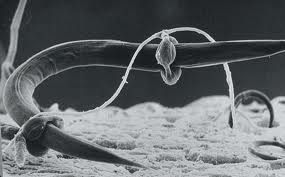Nematode trapping fungi: Difference between revisions
| Line 5: | Line 5: | ||
==Biological interaction== | ==Biological interaction== | ||
Nematophageous fungi and nematodes share a special predator-prey relationship. Nematodes produce a highly conserved family of small molecules called ascarosides. These small molecules are special to the nematodes and the fungi are able to detect these molecules. Studies have shown however, that these molecules are only being detected during periods of nutrient scarcity on the part of the fungi. | |||
===Detecting the Nematodes=== | |||
<br> | |||
=== | |||
====Subsection 1a==== | ====Subsection 1a==== | ||
<br> | |||
====Subsection 1b==== | ====Subsection 1b==== | ||
=== | <br> | ||
===Trapping the Nematodes=== | |||
<br> | <br> | ||
Revision as of 04:25, 8 April 2013
Introduction
Nematode trapping fungi, or “nematophageous fungi,” are carnivorous fungi that have developed methods and structures that enable them to successfully trap and consume nematodes. Nematode trapping fungi are responsible for keeping the nematode population in check and are an important part of the subsoil ecosystem. These fungi prey on nematodes and are in turn consumed by organisms on the next trophic level. Nematophageous fungi use several methods to hunt their prey. These methods include living within the nematode and slowly consuming them as well as spreading diseases through nematode populations. The fungi also live in the soil and set traps for the nematodes to squirm into.
Biological interaction
Nematophageous fungi and nematodes share a special predator-prey relationship. Nematodes produce a highly conserved family of small molecules called ascarosides. These small molecules are special to the nematodes and the fungi are able to detect these molecules. Studies have shown however, that these molecules are only being detected during periods of nutrient scarcity on the part of the fungi.
Detecting the Nematodes
Subsection 1a
Subsection 1b
Trapping the Nematodes
Niche
Describe the physical, chemical, or spatial characteristics of the niche where we might find this interaction, using as many sections/subsections as you require. Look at other topics available in MicrobeWiki. Create links where relevant.
Subsection 1
Subsection 1a
Subsection 1b
Subsection 2
Microbial processes
What microbial processes are important for this microbial interaction? Does this microbial interaction have some ecosystem-level effects? Does this interaction affect the environment in any way? Describe critical microbial processes or activities that are important in this interaction, adding sections/subsections as needed. Look at other topics in MicrobeWiki. Are some of these processes already described? Create links where relevant.
Subsection 1
Subsection 1a
Subsection 1b
Subsection 2
Key Microorganisms
What specific kinds of microbes are typically involved in this interaction? Or associated with important processes? Describe key groups (genera, species) of microbes that we find in this environment, and any special adaptations they may have evolved to survive in this environment. List examples of specific microbes that represent key groups or are associated with important processes found in this environment. Add sections/subsections as needed. Look at other microbe listings in MicrobeWiki. Are some of the groups of microbes from your environment already described? Create links to other MicrobeWiki pages where possible.
Subsection 1
Subsection 1a
Subsection 1b
Subsection 2
Current Research
Enter summaries of recent research here--at least three required
References
Edited by <your name>, a student of Angela Kent at the University of Illinois at Urbana-Champaign.

